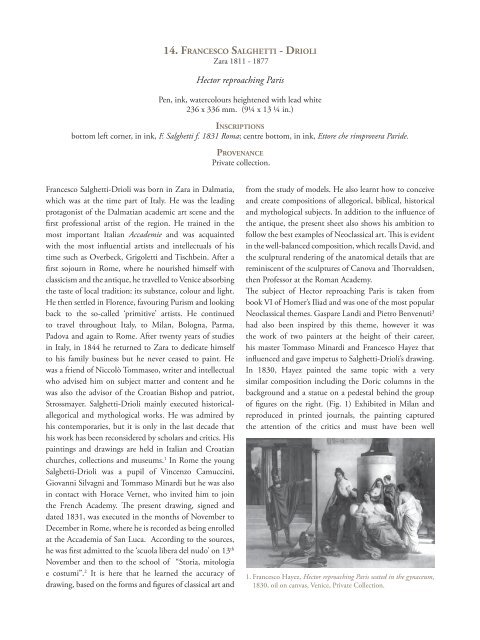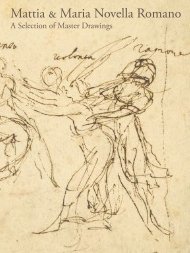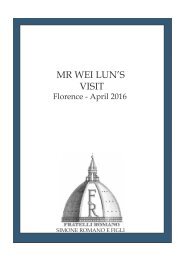A Selection of master drawings 2014
- No tags were found...
Create successful ePaper yourself
Turn your PDF publications into a flip-book with our unique Google optimized e-Paper software.
14. Francesco Salghetti - Drioli<br />
Zara 1811 - 1877<br />
Hector reproaching Paris<br />
Pen, ink, watercolours heightened with lead white<br />
236 x 336 mm. (9¼ x 13 ¼ in.)<br />
Inscriptions<br />
bottom left corner, in ink, F. Salghetti f. 1831 Roma; centre bottom, in ink, Ettore che rimprovera Paride.<br />
Provenance<br />
Private collection.<br />
Francesco Salghetti-Drioli was born in Zara in Dalmatia,<br />
which was at the time part <strong>of</strong> Italy. He was the leading<br />
protagonist <strong>of</strong> the Dalmatian academic art scene and the<br />
first pr<strong>of</strong>essional artist <strong>of</strong> the region. He trained in the<br />
most important Italian Accademie and was acquainted<br />
with the most influential artists and intellectuals <strong>of</strong> his<br />
time such as Overbeck, Grigoletti and Tischbein. After a<br />
first sojourn in Rome, where he nourished himself with<br />
classicism and the antique, he travelled to Venice absorbing<br />
the taste <strong>of</strong> local tradition: its substance, colour and light.<br />
He then settled in Florence, favouring Purism and looking<br />
back to the so-called ‘primitive’ artists. He continued<br />
to travel throughout Italy, to Milan, Bologna, Parma,<br />
Padova and again to Rome. After twenty years <strong>of</strong> studies<br />
in Italy, in 1844 he returned to Zara to dedicate himself<br />
to his family business but he never ceased to paint. He<br />
was a friend <strong>of</strong> Niccolò Tommaseo, writer and intellectual<br />
who advised him on subject matter and content and he<br />
was also the advisor <strong>of</strong> the Croatian Bishop and patriot,<br />
Strossmayer. Salghetti-Drioli mainly executed historicalallegorical<br />
and mythological works. He was admired by<br />
his contemporaries, but it is only in the last decade that<br />
his work has been reconsidered by scholars and critics. His<br />
paintings and <strong>drawings</strong> are held in Italian and Croatian<br />
churches, collections and museums. 1 In Rome the young<br />
Salghetti-Drioli was a pupil <strong>of</strong> Vincenzo Camuccini,<br />
Giovanni Silvagni and Tommaso Minardi but he was also<br />
in contact with Horace Vernet, who invited him to join<br />
the French Academy. The present drawing, signed and<br />
dated 1831, was executed in the months <strong>of</strong> November to<br />
December in Rome, where he is recorded as being enrolled<br />
at the Accademia <strong>of</strong> San Luca. According to the sources,<br />
he was first admitted to the ‘scuola libera del nudo’ on 13 th<br />
November and then to the school <strong>of</strong> “Storia, mitologia<br />
e costumi”. 2 It is here that he learned the accuracy <strong>of</strong><br />
drawing, based on the forms and figures <strong>of</strong> classical art and<br />
from the study <strong>of</strong> models. He also learnt how to conceive<br />
and create compositions <strong>of</strong> allegorical, biblical, historical<br />
and mythological subjects. In addition to the influence <strong>of</strong><br />
the antique, the present sheet also shows his ambition to<br />
follow the best examples <strong>of</strong> Neoclassical art. This is evident<br />
in the well-balanced composition, which recalls David, and<br />
the sculptural rendering <strong>of</strong> the anatomical details that are<br />
reminiscent <strong>of</strong> the sculptures <strong>of</strong> Canova and Thorvaldsen,<br />
then Pr<strong>of</strong>essor at the Roman Academy.<br />
The subject <strong>of</strong> Hector reproaching Paris is taken from<br />
book VI <strong>of</strong> Homer’s Iliad and was one <strong>of</strong> the most popular<br />
Neoclassical themes. Gaspare Landi and Pietro Benvenuti 3<br />
had also been inspired by this theme, however it was<br />
the work <strong>of</strong> two painters at the height <strong>of</strong> their career,<br />
his <strong>master</strong> Tommaso Minardi and Francesco Hayez that<br />
influenced and gave impetus to Salghetti-Drioli’s drawing.<br />
In 1830, Hayez painted the same topic with a very<br />
similar composition including the Doric columns in the<br />
background and a statue on a pedestal behind the group<br />
<strong>of</strong> figures on the right. (Fig. 1) Exhibited in Milan and<br />
reproduced in printed journals, the painting captured<br />
the attention <strong>of</strong> the critics and must have been well<br />
1. Francesco Hayez, Hector reproaching Paris seated in the gynaceum,<br />
1830, oil on canvas, Venice, Private Collection.





